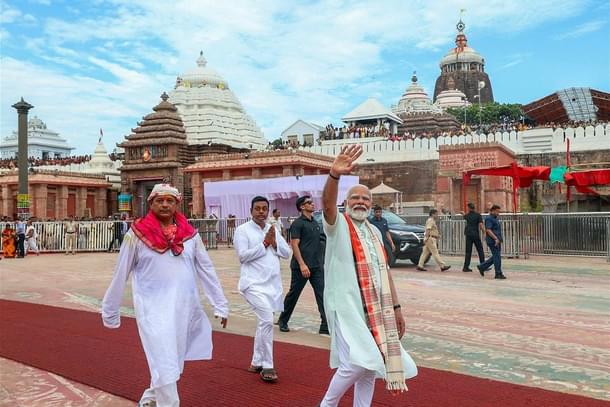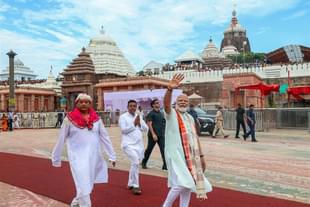States
After Opening All Four Gates Of Jagannath Mandir, It’s Time For BJP To Solve Ratna Bhandar Keys Controversy
Jaideep Mazumdar
Jun 17, 2024, 02:54 PM | Updated 02:51 PM IST
Save & read from anywhere!
Bookmark stories for easy access on any device or the Swarajya app.


Prime Minister Narendra Modi and other top BJP leaders had, while campaigning in Odisha for the recently-concluded Lok Sabha elections, promised to open all four gates of the Jagannath Mandir and get to the bottom of the controversy over the missing keys to the temple's ‘Ratna Bhandar’.
They had promised to make the 324-page report of the Justice Raghubir Das committee set up in June 2018 to probe the missing keys controversy public. The report was submitted to the Naveen Patnaik government in November 2018, but was kept under wraps by the state government.
One of the first acts of the new BJP government in the state was to open all four gates of the Jagannath Mandir, as was promised by the party bigwigs during the poll campaign. Having honoured that poll promise, the new Mohan Charan Majhi government in Odisha should now make the report on the missing keys to the Ratna Bhandar public.
And, also as promised by Union Home Minister Amit Shah, the state government should institute an enquiry into the whole controversy and trace the missing keys of the Ratna Bhandar.
This controversy has been raging since 1 June 2018, when the then Puri district collector, who is the custodian of the keys to the ‘bhitar bhandar’ (inner chamber) of the Ratna Bhandar, declared that the keys were missing.
That triggered an uproar, forcing former chief minister Naveen Patnaik to order a judicial enquiry. The enquiry commission, headed by former Chief Justice of the Odisha High Court, Justice Raghubir Das, submitted its report in November that year.
But what had created more controversy was a sudden announcement on 13 June that year by the Puri district administration that a set of duplicate keys to the bhitar bhandar had been discovered. Since the existence of duplicate keys to the bhandar was never known earlier, allegations of foul play and theft of gold and silver from the bhandar gained currency.
The new BJP government in the state should also make good another electoral promise: that of compensating and rehabilitating traders who were evicted during the ‘Srimandir Parikrama’ project.
The Rs 800-crore project, which was completed in January this year, resulted in hundreds of traders being evicted and the buildings that housed their establishments being demolished to make way for a 75-metre wide ‘parikrama’ around the temple complex and construction of public conveniences.
None of the traders received any compensation or were offered rehabilitation because their premises were owned by and were part of various mutts and they used to pay a very nominal rent. The refusal by the state government to pay any compensation to the traders or rehabilitate them created a lot of resentment in Puri.
It is important to understand what the controversy surrounding the missing keys to the bhitar bhandar is all about. Here’s an explainer:
Gold and silver ornaments and objects offered to the deities are kept at the Ratna Bhandar which lies adjacent to the Jagamohan (prayer hall) to the north of the main temple.
The Ratna Bhandar has two chambers — the inner chamber of bhitar bhandar and the outer chamber called the ‘bahar bhandar’. Gold and silver, mostly in the form of ornaments, utensils and other objects, that are never used in the temple’s rituals (listed as category 3) are kept in the bhitar bhandar.
Only those ornaments and objects used on ceremonial and festive occasions (category 2 articles) and the ones for everyday use (category 1) are kept in the bahar bhandar.
The last inventory of the treasures in both the chambers was carried out in 1978. The bhitar bhandar had 367 gold objects, including ornaments studded with precious stones and plates and other objects studded with diamonds and pearls, and 231 silver articles.
The bahar bhandar had 87 gold articles (including ornaments) and 62 silver items.
Cumulatively, the two chambers have 149 kilos of gold ornaments and objects and 258 kilos of silver ornaments and articles. Of this, the bhitar bhandar had 120 kilos of gold ornaments and objects and 220 kilos of silver ornaments and articles.
The keys to the bhitar bhandar are kept in the government treasury. The bhitar bhandar had been opened only four times in the last century: in 1905, 1926, 1978 and 1984.
On 4 April 2018, a 16-member team, including two representatives of the Archaeological Survey of India (ASI), tried to carry out a fresh inventory of the treasures in the bhitar bhandar, but were unable to do so because the keys could not be located.
This fresh inventory was attempted on the orders of the Orissa High Court which had been monitoring repair works at the temple since 2016.
Reports of the 16-member team being unable to enter the bhitar bhandar since the keys could not be located sparked a huge outcry.
This outcry turned into state-wide indignation and agitation when the then Puri district collector, Arvind Agarwal, informed the Shree Jagannath Temple Administration (SJTA) on 1 June 2018, that the keys to the bhitar bhandar were missing.
This revelation led to widespread rumours that the state government, which had taken over the administration of Shree Jagannath Mandir in 1952, had surreptitiously stolen valuables from the Ratna Bhandar.
Such was the outcry that Chief Minister Naveen Patnaik ordered a judicial enquiry headed by retired Chief Justice of the Orissa High Court, Justice Raghubir Das, on 5 June 2018.
To make matters worse, the Puri district administration announced on 13 June that a set of duplicate keys to the bhitar bhandar had been discovered in an envelope in the district records room.
Questions were immediately raised about how and when duplicate keys to the bhitar bhandar were made, and on whose orders.
In November 2018, the Justice Das committee submitted its report running into 324 pages. But the state government went back on its initial promise and refused to divulge the findings of the committee.
This refusal prompted suspicion that the state government was hiding ‘something very big’ from the public.
On 4 August 2023, the Jagannath Temple Managing Committee recommended a comprehensive audit of the treasures in the Ratna Bhandar and requested the state government, which has a final say on the matter, to carry out this audit.
The state government sat on this recommendation for six months, and only in February this year, on the explicit orders of the Orissa High Court, did the Naveen Patnaik government form a 12-member committee to carry out this audit.
However, nothing is known about what this committee has done so far.
It is high time that the controversy over the missing keys is laid to rest. And, more importantly, a transparent and comprehensive audit of the treasures inside both the chambers of the Ratna Bhandar are carried out.





